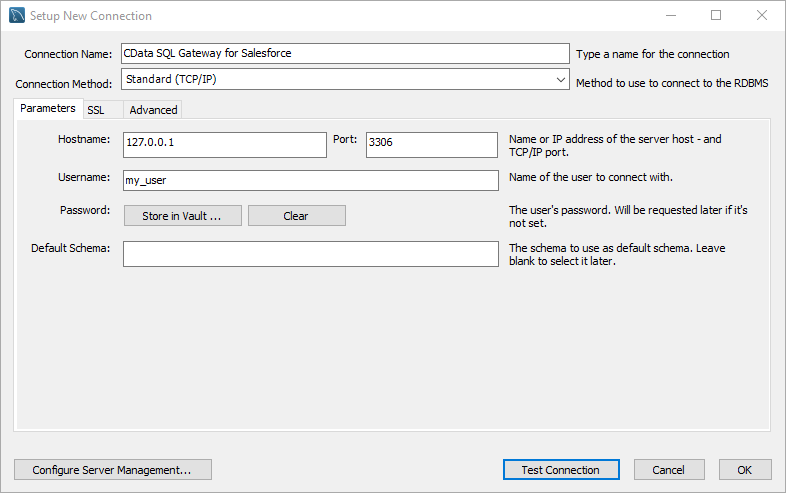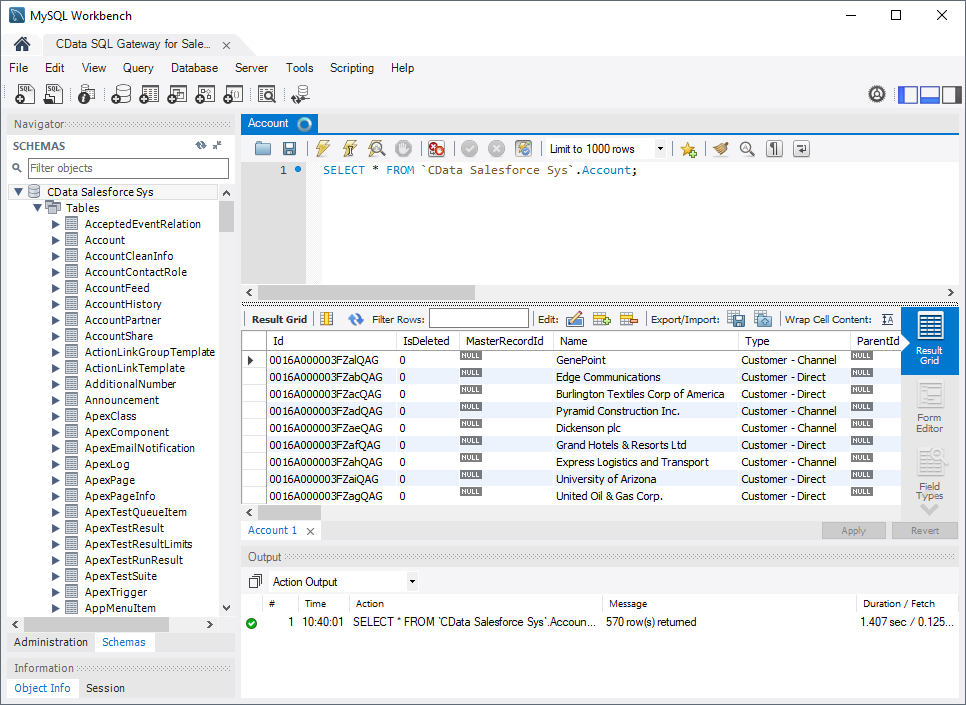Discover how a bimodal integration strategy can address the major data management challenges facing your organization today.
Get the Report →How to Query AlloyDB Data in MySQL Workbench
Execute MySQL queries against live AlloyDB data from MySQL Workbench.
You can use the SQL Gateway from the ODBC Driver for AlloyDB to query AlloyDB data through a MySQL interface. Follow the procedure below to start the MySQL remoting service of the SQL Gateway and work with live AlloyDB data in MySQL Workbench.
Connect to AlloyDB Data
If you have not already done so, provide values for the required connection properties in the data source name (DSN). You can use the built-in Microsoft ODBC Data Source Administrator to configure the DSN. This is also the last step of the driver installation. See the "Getting Started" chapter in the help documentation for a guide to using the Microsoft ODBC Data Source Administrator to create and configure a DSN.
The following connection properties are usually required in order to connect to AlloyDB.
- Server: The host name or IP of the server hosting the AlloyDB database.
- User: The user which will be used to authenticate with the AlloyDB server.
- Password: The password which will be used to authenticate with the AlloyDB server.
You can also optionally set the following:
- Database: The database to connect to when connecting to the AlloyDB Server. If this is not set, the user's default database will be used.
- Port: The port of the server hosting the AlloyDB database. This property is set to 5432 by default.
Authenticating with Standard Authentication
Standard authentication (using the user/password combination supplied earlier) is the default form of authentication.
No further action is required to leverage Standard Authentication to connect.
Authenticating with pg_hba.conf Auth Schemes
There are additional methods of authentication available which must be enabled in the pg_hba.conf file on the AlloyDB server.
Find instructions about authentication setup on the AlloyDB Server here.
Authenticating with MD5 Authentication
This authentication method must be enabled by setting the auth-method in the pg_hba.conf file to md5.
Authenticating with SASL Authentication
This authentication method must be enabled by setting the auth-method in the pg_hba.conf file to scram-sha-256.
Authenticating with Kerberos
The authentication with Kerberos is initiated by AlloyDB Server when the ∏ is trying to connect to it. You should set up Kerberos on the AlloyDB Server to activate this authentication method. Once you have Kerberos authentication set up on the AlloyDB Server, see the Kerberos section of the help documentation for details on how to authenticate with Kerberos.
Configure the SQL Gateway
See the SQL Gateway Overview to set up connectivity to AlloyDB data as a virtual MySQL database. You will configure a MySQL remoting service that listens for MySQL requests from clients. The service can be configured in the SQL Gateway UI.

Query AlloyDB from MySQL Workbench
The steps below outline connecting to the virtual AlloyDB database created in the SQL Gateway from MySQL Workbench and issuing basic queries to work with live AlloyDB data.
Connect to AlloyDB through the SQL Gateway
- In MySQL Workbench, click to add a new MySQL connection.
- Name the connection (CData SQL Gateway for AlloyDB).
- Set the Hostname, Port, and Username parameters to connect to the SQL Gateway.
- Click Store in Vault to set and store the password.
- Click Test Connection to ensure the connection is configured properly and click OK.
NOTE: When we refer to Username and Password, we mean the credentials for the user(s) created for the SQL Gateway.

Query AlloyDB Data
- Open the connection you just created (CData SQL Gateway for AlloyDB).
- Click File -> New Query Tab.
- Write a SQL query to retrieve AlloyDB data, like SELECT * FROM `CData AlloyDB Sys`.Orders;

With access to live AlloyDB data from MySQL Workbench, you can easily query and update AlloyDB, just like you would a MySQL database. Get started now with a free, 30-day trial of the CData ODBC Driver for AlloyDB and the CData SQL Gateway.





